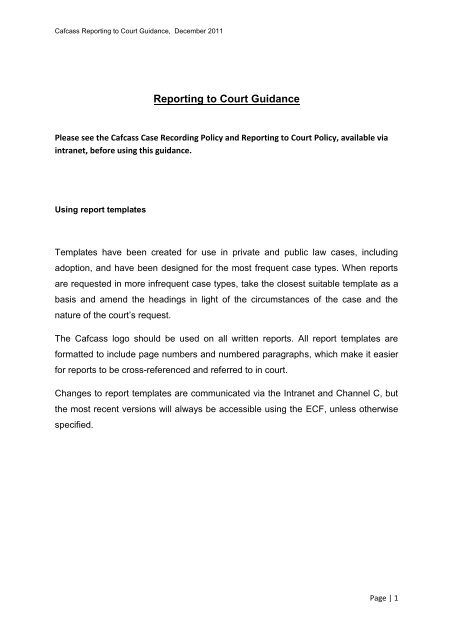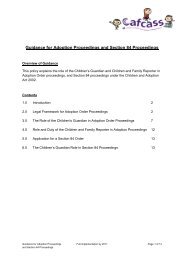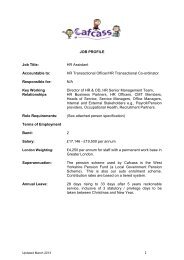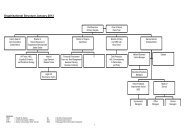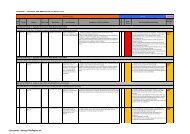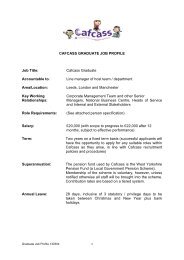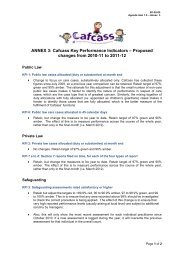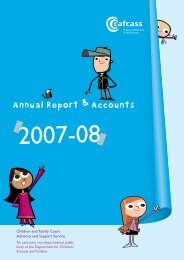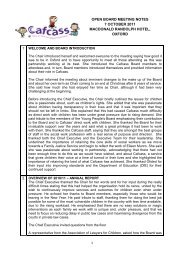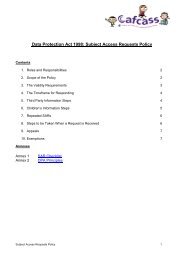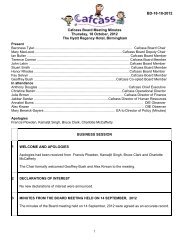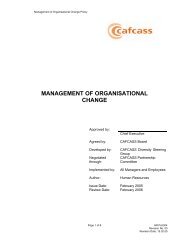Reporting to Court Guidance - Cafcass
Reporting to Court Guidance - Cafcass
Reporting to Court Guidance - Cafcass
You also want an ePaper? Increase the reach of your titles
YUMPU automatically turns print PDFs into web optimized ePapers that Google loves.
<strong>Cafcass</strong> <strong>Reporting</strong> <strong>to</strong> <strong>Court</strong> <strong>Guidance</strong>, December 2011<br />
<strong>Reporting</strong> <strong>to</strong> <strong>Court</strong> <strong>Guidance</strong><br />
Please see the <strong>Cafcass</strong> Case Recording Policy and <strong>Reporting</strong> <strong>to</strong> <strong>Court</strong> Policy, available via<br />
intranet, before using this guidance.<br />
Using report templates<br />
Templates have been created for use in private and public law cases, including<br />
adoption, and have been designed for the most frequent case types. When reports<br />
are requested in more infrequent case types, take the closest suitable template as a<br />
basis and amend the headings in light of the circumstances of the case and the<br />
nature of the court’s request.<br />
The <strong>Cafcass</strong> logo should be used on all written reports. All report templates are<br />
formatted <strong>to</strong> include page numbers and numbered paragraphs, which make it easier<br />
for reports <strong>to</strong> be cross-referenced and referred <strong>to</strong> in court.<br />
Changes <strong>to</strong> report templates are communicated via the Intranet and Channel C, but<br />
the most recent versions will always be accessible using the ECF, unless otherwise<br />
specified.<br />
Page | 1
<strong>Cafcass</strong> <strong>Reporting</strong> <strong>to</strong> <strong>Court</strong> <strong>Guidance</strong>, December 2011<br />
Pasting from other documents<br />
Sometimes it can be helpful <strong>to</strong> copy and paste content in<strong>to</strong> a report template from<br />
another document. When doing this, it is always advisable <strong>to</strong> use Paste Special, as<br />
this ensures that existing formatting is not changed.<br />
1. Copy the text you wish <strong>to</strong> transfer from another document.<br />
2. Select the Home menu of the report template.<br />
3. Click on the arrow underneath the Paste but<strong>to</strong>n and select Paste<br />
Special.<br />
4. In the window of the Past Special box, select Paste Unformatted<br />
Text and click OK.<br />
Attending court<br />
When attending court, practitioners should present themselves professionally.<br />
Punctuality is important, and it is preferable for practitioners <strong>to</strong> arrive prior <strong>to</strong> the<br />
schedule starting. Practitioners should be dressed appropriately for the formality of<br />
the court, and should have access <strong>to</strong> the case plan and other relevant information.<br />
When speaking in court, practitioners should face and address the judge at all times,<br />
and should speak clearly with appropriate pauses.<br />
Referring <strong>to</strong> parties<br />
It is generally good practice <strong>to</strong> refer <strong>to</strong> adults by their surname and title (e.g. Mr, Ms)<br />
in written court reports and when speaking in court.<br />
In written reports, it is useful <strong>to</strong> make clear the relationship of each adult, referred <strong>to</strong><br />
in the report, <strong>to</strong> the subject child/ren, on the first occasion that the adult is mentioned<br />
in the report.<br />
Page | 2
<strong>Cafcass</strong> <strong>Reporting</strong> <strong>to</strong> <strong>Court</strong> <strong>Guidance</strong>, December 2011<br />
Addressing judges in court<br />
Type of court Type of<br />
judge<br />
In court<br />
<strong>Court</strong> of appeal Lord Justices My Lord<br />
My Lady<br />
In letter<br />
Lord / Lady Justice X<br />
High <strong>Court</strong> (family<br />
division)<br />
County court (care<br />
centre)<br />
Family proceedings<br />
court (magistrates<br />
court)<br />
High <strong>Court</strong><br />
judges<br />
My Lord<br />
My Lady<br />
The Honourable Mr / Mrs<br />
Justice X<br />
Dear Mr / Mrs Justice X<br />
Circuit judges Your honour His / her Honour Judge X<br />
Dear Judge X<br />
District judges Sir / Ma’am Dear District Judge X<br />
District judges Sir / Ma’am Dear District Judge X<br />
Lay<br />
Magistrates<br />
Your<br />
Worships /<br />
Sir, Ma’am<br />
Dear Sir / Madam<br />
Outside court, all judges can be addressed as Judge, except for the President of the<br />
Family Division who should be addressed as ‘President’.<br />
Page | 3
<strong>Cafcass</strong> <strong>Reporting</strong> <strong>to</strong> <strong>Court</strong> <strong>Guidance</strong>, December 2011<br />
Order of appearance<br />
For giving oral evidence in court, the order of appearance is generally as follows<br />
(unless directed otherwise by the court):<br />
Public law<br />
Applicant (usually local authority)<br />
Respondents with parental responsibility (usually parents)<br />
Other respondents (usually parents without PR)<br />
Children’s Guardian<br />
Child (though evidence-giving by children is rare)<br />
Closing speeches: Respondents; Applicant; Children’s Guardian<br />
Private law<br />
Applicant opens case<br />
<strong>Cafcass</strong><br />
Applicant<br />
Respondents with PR<br />
Any other respondent<br />
Child (though evidence-giving by children is rare)<br />
Closing speeches: Respondent(s); Applicant<br />
While the <strong>Cafcass</strong> report has the status of being the main evidence, the fact that<br />
family proceedings are inquisi<strong>to</strong>rial in nature will make it quite possible that the<br />
bench (magistrates or judges) will wish <strong>to</strong> ask further questions, in addition <strong>to</strong> any<br />
cross-examination that may take place, conducted by the parties or (more usually)<br />
their legal representatives. Therefore, it is helpful if practitioners are familiar not only<br />
with the content of their written reports, but also with the materials on which they are<br />
based, including those that might have been provided by colleagues (e.g. <strong>Cafcass</strong><br />
duty officers).<br />
Page | 4
<strong>Cafcass</strong> <strong>Reporting</strong> <strong>to</strong> <strong>Court</strong> <strong>Guidance</strong>, December 2011<br />
The Welfare Checklist<br />
There is a statu<strong>to</strong>ry requirement that the Welfare Checklist, set out in the Children<br />
Act, 1989 has <strong>to</strong> be the paramount consideration in determining a child's upbringing.<br />
The <strong>Cafcass</strong> templates do not set out the welfare checklist in full, but require the<br />
practitioner <strong>to</strong> include the relevant sections in their analysis. The full checklist is<br />
provided at the end of this guidance.<br />
In public law, for final hearings where matters are fully contested, or for other<br />
contested hearings, you will always need <strong>to</strong> set out the checklist in full. The<br />
court wants <strong>Cafcass</strong> <strong>to</strong> focus on relevant analysis not description; <strong>to</strong> emphasize<br />
‘sorting’ not ‘reporting’; and <strong>to</strong> be brief and specific in style not discursive.<br />
Practitioners are expected <strong>to</strong> use their professional judgement in deciding which<br />
elements of the checklist should be addressed in every court report, bearing in mind<br />
the purpose of the particular report, the issue it is addressing, what the court has<br />
asked <strong>Cafcass</strong> <strong>to</strong> do, and the nature of the hearing it is for. This is approach is far<br />
more effective and appropriate as opposed <strong>to</strong> a formulaic approach in which the<br />
welfare checklist headings are listed yet not relevant <strong>to</strong> the issues the court has<br />
ordered <strong>to</strong> be addressed for that particular report.<br />
In reporting <strong>to</strong> court in private law, the checklist comes in<strong>to</strong> force because of the<br />
requests that the court makes of <strong>Cafcass</strong> and because of the effect of the court rules<br />
in empowering the court <strong>to</strong>, in effect, in part <strong>to</strong> ‘sub contract’ its responsibilities on<strong>to</strong><br />
<strong>Cafcass</strong>. These responsibilities are not subcontracted in full in all cases, regardless<br />
of the extent <strong>to</strong> which the court has asked <strong>Cafcass</strong> <strong>to</strong> assist in the circumstances of<br />
each specific case. This is why the questions set out in the Schedule 2 letter are<br />
narrowly drawn, being focused on the provision of information that <strong>Cafcass</strong> has<br />
uncovered as part of its screening checks. It is only at the first hearing that the court<br />
can exercise the judgement that it is required <strong>to</strong> make under section 1(4) of the<br />
Children Act 1989, which may result in the court having then <strong>to</strong> meet its section 1(3)<br />
responsibilities. When reporting following first hearing it is helpful <strong>to</strong> the court <strong>to</strong><br />
make specific reference <strong>to</strong> the items of the welfare checklist that are addressed in<br />
Page | 5
<strong>Cafcass</strong> <strong>Reporting</strong> <strong>to</strong> <strong>Court</strong> <strong>Guidance</strong>, December 2011<br />
the report <strong>to</strong> the court, but in the context of what it is that the court has asked<br />
<strong>Cafcass</strong> <strong>to</strong> do.<br />
The Welfare Checklist is set out here in full:<br />
The Children Act 1989: Statu<strong>to</strong>ry Welfare Checklist<br />
Under Section 1(3) of the Children Act 1989 the court must have regard in particular<br />
<strong>to</strong> :-<br />
1. the ascertainable wishes and feelings of the child concerned (considered in<br />
the light of his age and understanding)<br />
2. his physical, emotional and educational needs<br />
3. the likely effect of any change in his circumstances<br />
4. his age, sex, background and any characteristics of his which the court<br />
considers relevant<br />
5. any harm which he has suffered or is at risk of suffering<br />
6. how capable each of his parents, and any other person in relation <strong>to</strong> whom<br />
the court considers the question <strong>to</strong> be relevant, is of meeting his needs<br />
7. the range of powers available <strong>to</strong> the court under this Act in the proceedings in<br />
question.<br />
Page | 6
<strong>Cafcass</strong> <strong>Reporting</strong> <strong>to</strong> <strong>Court</strong> <strong>Guidance</strong>, December 2011<br />
The PLO Funnel Model<br />
The ‘funnel’ model for PLO cases represents the narrowing of issues through sets of<br />
questions for the Children’s Guardian <strong>to</strong> consider at each stage of the PLO.<br />
First Appointment<br />
fadfdfffffffffffffffafggdg<br />
Pre-proceedings checklist – are there gaps e.g. viability / kinship assessments?<br />
Have any immediate concerns about safety or care of the children been acted upon?<br />
Has the LA established a clear picture of the individual child’s needs, wishes and feelings (in<br />
non-emergency cases)?<br />
Has the LA made checks of Police records?<br />
Have the parent/s and any other parties been served notice of proceedings? Have they had<br />
access <strong>to</strong> legal advice? Have any special needs of the parents been addressed? Does<br />
appointment of the OS need <strong>to</strong> be considered?<br />
Relevant diversity issues e.g. Is there a need for interpreter or other assistance?<br />
Should anyone else be made a party, due <strong>to</strong> their involvement at this stage?<br />
Which key issues are clear and which remain <strong>to</strong> be addressed? How do you think they can<br />
best be addressed?<br />
Is there a need for expert assessment on any specific issue, taking the child’s timetable and<br />
case complexity in<strong>to</strong> account?<br />
Are the proceedings in the appropriate forum?<br />
What timetable, for the court, would be appropriate in best meeting the child’s individual<br />
timetable?<br />
Is ‘fast-tracking’ necessary and possible?<br />
Are any interim orders required?<br />
Case Management Conference<br />
What are the critical issues in the case remaining <strong>to</strong> be<br />
assessed, determined or resolved?<br />
At this stage, what is happening for the child/ren?<br />
What are their views, needs, wishes and feelings about<br />
e.g. schooling, placement, or other relevant welfare<br />
checklist issues?<br />
Is there need for separate representation?<br />
What are the safe and positive options for their future<br />
care or contact e.g. safe reunification programme;<br />
kinship care?<br />
What further assessments, including expert<br />
assessments, are outstanding?<br />
What are the child’s needs in the court process in the<br />
context of the child’s individual timetable?<br />
Has the LA started any necessary parallel / concurrent<br />
planning?<br />
Page | 7
<strong>Cafcass</strong> <strong>Reporting</strong> <strong>to</strong> <strong>Court</strong> <strong>Guidance</strong>, December 2011<br />
Issues Resolution Hearing<br />
Has all the evidence been filed in accordance with the previous order?<br />
Is any other evidence required and/or any other further reports and/or any<br />
other expert evidence?<br />
In the context of the evidence filed, what are the critical issues <strong>to</strong> be<br />
determined?<br />
In the context of the evidence filed, what is the optimum care plan for the<br />
child?<br />
What is happening for the child/ren? Have their views, needs, wishes and<br />
feelings changed? Has the child/ren’s timetable changed?<br />
Any relevant issues from the welfare checklist?<br />
Are there outstanding issues with the LA care plan (if any) with which the CG<br />
goes not agree?<br />
If the CG is not in agreement with the parents’ position, why?<br />
If the placement is with friends and family, ask: What is the support and moni<strong>to</strong>ring? What<br />
is identified as not being good enough i.e. what would be the trigger for moving?<br />
Contingency? (and where going back <strong>to</strong> family) what has changed?<br />
Final Hearing<br />
Any remaining relevant issues from the welfare<br />
checklist?<br />
Analysis of parties’ positions<br />
Are there any outstanding issues with the care<br />
plan?<br />
Have other issues been identified by the court<br />
that remain <strong>to</strong> be addressed?<br />
What are the child’s views, needs, wishes and<br />
feelings at this stage, for the short and long<br />
term?<br />
Has the child been offered an opportunity <strong>to</strong> visit<br />
the court?<br />
Have arrangements been made <strong>to</strong> liaise with the<br />
IRO at end of case?<br />
How will the child be informed of the final<br />
outcome?<br />
Final recommendation.<br />
Page | 8
<strong>Cafcass</strong> <strong>Reporting</strong> <strong>to</strong> <strong>Court</strong> <strong>Guidance</strong>, December 2011<br />
Checklist for reports at First Appointment (public law)<br />
If you have time and sufficient knowledge (for example, where you have<br />
worked with the family before) you may be in a position <strong>to</strong> complete the<br />
written Initial Analysis and Recommendations document or short assurance<br />
statement in time for this first hearing. The decision about whether <strong>to</strong> provide<br />
an oral resumé or a written document is for you <strong>to</strong> make, based on the<br />
circumstances of the case.<br />
Any information or advice needs <strong>to</strong> be qualified by the statement that this is<br />
based on information received so far, and may change as the case develops.<br />
The list of areas <strong>to</strong> address is intended as a prompt only. It is neither a<br />
minimum standard, nor a definitive list. It is important <strong>to</strong> clarify for the court<br />
how much of a contribution you can make at this stage.<br />
Your analysis or position statement needs <strong>to</strong> be analytical, not descriptive.<br />
The child’s own contribution needs <strong>to</strong> be promoted from the outset –<br />
whenever possible report on the child’s views of all the fac<strong>to</strong>rs below,<br />
alongside or integrated in<strong>to</strong> your own analysis.<br />
Provide a brief outline of work done so far:<br />
Documents seen<br />
<strong>Cafcass</strong> screening and risk identification – any issues raised<br />
Contact with child/ren<br />
Contact with family members<br />
Contact with professional network<br />
Pre-proceedings checklist – are there gaps?<br />
Are there immediate concerns about safety or care of the child/ren?<br />
Have the parent/s and any other parties received legal advice?<br />
Relevant diversity issues<br />
Is there a need for an interpreter or other assistance?<br />
Should other people be made parties?<br />
What are the issues at stake? Are there other issues that need addressing,<br />
not identified within the application?<br />
What information is there of the child/ren’s wishes and feelings?<br />
Does the information provided seem adequate <strong>to</strong> resolve the issues at stake?<br />
What are the gaps?<br />
Is there need for expert assessment?<br />
Is there need for a finding of fact?<br />
Are there any issues that are no longer in dispute?<br />
What timetable for the court would be appropriate in best meeting the<br />
child/ren’s timetable?<br />
Are any interim orders required?<br />
Page | 9
<strong>Cafcass</strong> <strong>Reporting</strong> <strong>to</strong> <strong>Court</strong> <strong>Guidance</strong>, December 2011<br />
Is ‘fast-tracking’ necessary and possible?<br />
Potential need for separate representation? Official Solici<strong>to</strong>r involvement?<br />
What level of involvement is anticipated for <strong>Cafcass</strong> based on the above<br />
analysis?<br />
Page | 10


